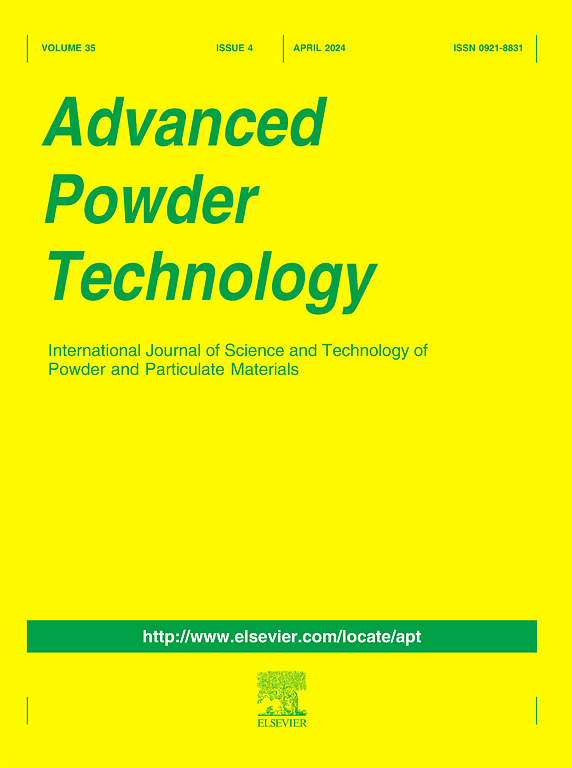片状和球形铝粉的微观结构和燃烧性能对比分析及其在切屑自毁中的应用
IF 4.2
2区 工程技术
Q2 ENGINEERING, CHEMICAL
引用次数: 0
摘要
铝粉的燃烧性能与其微观结构特征密切相关,这对铝粉作为金属燃料的工程适用性有重要影响。本研究采用扫描电镜(SEM)、能谱仪(EDS)、x射线衍射仪(XRD)和氧弹量热仪等技术,对6种片状铝粉和6种球形铝粉的微观结构特征和燃烧性能进行了对比研究。并对基于铝粉的芯片自毁技术进行了研究。结果表明,随着片状铝粉粒度的增大,活性铝含量也随之增加,导致燃烧热值增大。粒径较小的片状铝粉表现出团聚现象。片状铝粉的凝聚燃烧产物是由分散的灰白色颗粒组成,存在多个较小的碎片。片状铝粉粒径越小,凝固时其燃烧产物越分散;相反,较大的粒子倾向于聚结。片状铝粉燃烧产物的主要成分是3Al2O3·2SiO2和Al2O3晶体。对于球形铝粉,燃烧热值和效率随粒径的增大而增大,纳米级和微米级铝粉的燃烧热值和效率差异显著。球形铝粉的燃烧产物由紧密粘附的黑、白色凝聚相燃烧产物组成,同时在坩埚壁面和底部分布着少量灰白色颗粒。片状和球形铝粉复合燃料的点火过程包括着火、爆燃、稳定燃烧、火焰衰减和熄灭五个阶段,铝粉的微观结构差异对每个阶段的影响都很显著。片状铝粉的点火延迟时间比球形铝粉短,燃烧强度更高,可燃性更强,而球形铝粉的燃烧持续时间更长。片状铝粉复合燃料和球形铝粉复合燃料都能对芯片及其引线造成不可逆的物理损伤,实现有效破坏。本文章由计算机程序翻译,如有差异,请以英文原文为准。

Comparative analysis of microstructure and combustion performance of flake and spherical aluminum powder and its application in chip self-destruction
The combustion performance of aluminum powder is closely related to its microstructural features, which significantly influence the engineering applicability of aluminum powder as metal fuel. In this study, six types of flake aluminum powders and six types of spherical aluminum powders were selected for a comparative investigation of their microstructural characteristics and combustion performance, employing techniques of Scanning Electron Microscopy (SEM), Energy Dispersive Spectroscopy (EDS), X-ray Diffraction (XRD), and oxygen bomb calorimetry. Additionally, research was conducted on the chip self-destruction technology based on aluminum powder. The results indicate that as the particle size of flake aluminum powder increases, the content of reactive aluminum also rises, leading to enhanced combustion heat value. Smaller-sized flake aluminum powders exhibited agglomeration phenomena. The condensed combustion products of flake aluminum powder are composed of dispersed gray-white particles, with multiple smaller fragments present. The smaller the particle size of the flake aluminum powder, the more dispersed its combustion products appear upon solidification; conversely, larger particles tend to coalesce. The primary composition of the combustion products of flake aluminum powders consists of 3Al2O3·2SiO2 and Al2O3 crystals. For spherical aluminum powders, both the combustion heat value and efficiency increase with larger particle size, with notable differences observed between nano-sized and micron-sized aluminum powders regarding combustion heat value and efficiency. The combustion products of spherical aluminum powders consist of closely adhered black and white condensed phase combustion products, along with a few gray-white particles distributed on the walls and bottom of the crucible. The ignition process of both flake and spherical aluminum powder composite fuels comprises five stages: ignition, deflagration, stable combustion, flame decay, and extinguishing, with significant effects of the microstructural differences in aluminum powders on each stage. The ignition delay time for flake aluminum powders is shorter than that for spherical aluminum powders, accompanied by a higher intensity of combustion, indicating greater flammability, while spherical aluminum powders exhibit longer combustion durations. Both flake aluminum powder composite fuels and spherical aluminum powder composite fuels can cause irreversible physical damage to chips and their leads, achieving effective destruction.
求助全文
通过发布文献求助,成功后即可免费获取论文全文。
去求助
来源期刊

Advanced Powder Technology
工程技术-工程:化工
CiteScore
9.50
自引率
7.70%
发文量
424
审稿时长
55 days
期刊介绍:
The aim of Advanced Powder Technology is to meet the demand for an international journal that integrates all aspects of science and technology research on powder and particulate materials. The journal fulfills this purpose by publishing original research papers, rapid communications, reviews, and translated articles by prominent researchers worldwide.
The editorial work of Advanced Powder Technology, which was founded as the International Journal of the Society of Powder Technology, Japan, is now shared by distinguished board members, who operate in a unique framework designed to respond to the increasing global demand for articles on not only powder and particles, but also on various materials produced from them.
Advanced Powder Technology covers various areas, but a discussion of powder and particles is required in articles. Topics include: Production of powder and particulate materials in gases and liquids(nanoparticles, fine ceramics, pharmaceuticals, novel functional materials, etc.); Aerosol and colloidal processing; Powder and particle characterization; Dynamics and phenomena; Calculation and simulation (CFD, DEM, Monte Carlo method, population balance, etc.); Measurement and control of powder processes; Particle modification; Comminution; Powder handling and operations (storage, transport, granulation, separation, fluidization, etc.)
 求助内容:
求助内容: 应助结果提醒方式:
应助结果提醒方式:


